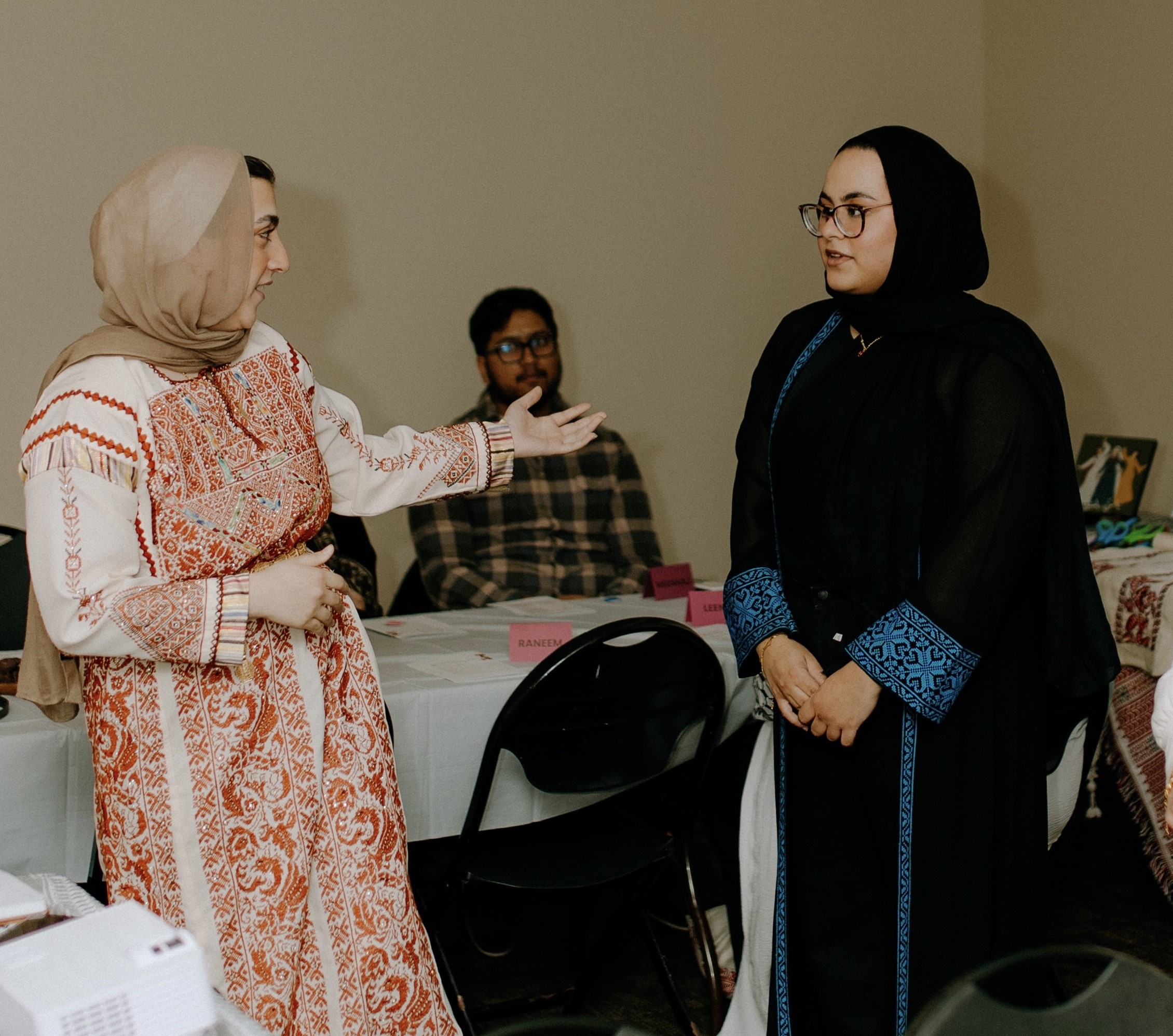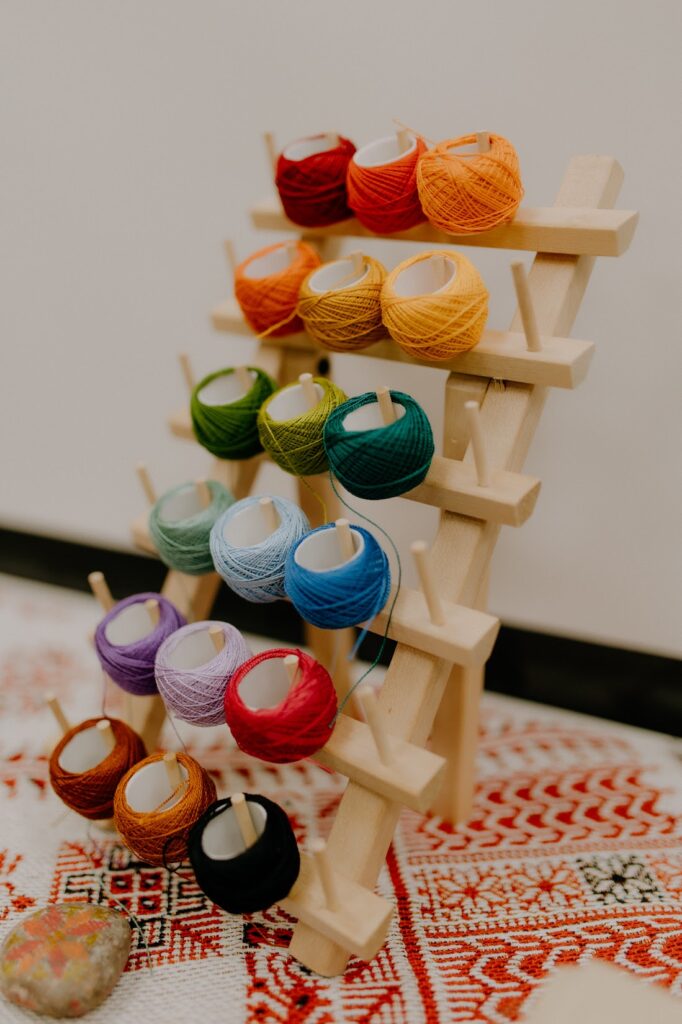Making a Statement with Traditional Clothing
By Kiran Ansari
July/Aug 2024

Anwaar Saadeh’s mom always had Palestinian decor around the house, even though they had migrated from there to Chicago during the 1970s. “It felt like a museum of artifacts I had to appreciate but didn’t know why. It wasn’t until I was old enough to ask the right questions that my parents told me the stories behind every piece found in our house,” Saadeh told Islamic Horizons. “I learned my mom made and sold beaded flower pots to help my dad with the bills when they first moved to America. She had made tatreez pillows as a little girl in Palestine, and they had souvenirs from Jerusalem because they smelt like home.”
Her parents worked hard to keep Palestinian culture alive. She remembers being taken across Chicagoland to meet other Palestinians since she was a little girl. “I come from a very long line of farmers who have taught me that working with my hands is something I can always find solace in,” Saadeh said. “Even in our backyard in Chicago, we try to garden the way my parents did in Palestine before they immigrated here, while they share practices and secrets whispered by their parents and forefathers.”
Reem Hussein, another first-generation Palestinian American, had been exposed to tatreez all her life, for her mother and all her aunts are avid embroiderers. However, her personal journey began in March 2020 amid the anxiety of college exams, restlessness brought on by Covid’s quarantine and a longing for connection. “Unlike my transient hobbies, tatreez resonated with me on a deeper level — it became a meaningful conduit to reconnect with my heritage and roots,” Hussein said.
While growing up, these young women didn’t see the thobe, a traditional Palestinian dress, as just attire for special occasions, but as a symbol of their heritage. “Learning to tatreez wasn’t about mastering a skill; it was a journey of self-discovery and cultural reconnection,” Hussein stated. “Through each stitch, I found a deeper appreciation for the strength and creativity of Palestinian women, whose efforts have been a powerful form of resistance.”
Tatreez isn’t just about adornment or embroidery – it’s a centuries-long artistic tradition passed down from mother to daughter. While Israel was attempting to cleanse the land of its people and history, tatreez was used to tell stories. It didn’t just beautify homes and bodies, but also bonded women and kept their families fed.
Once you understand this artform’s history, you can gain a newfound respect and appreciation for those who produce these works. They can provide a look into women’s roles in the resistance beyond the more visible physical resistance, for their products continue to evolve a centuries-old tradition so that it can include the Nakba, the Naksa and the two Intifadas. The Palestinians’ commitment to ensuring that no one forgets is unmatched and has provided a window into a rich, unique and revolutionary culture.
Learning Tatreez
Hussein founded Jariri Stitching with the intention of fostering consistency in her creative pursuits. Through social media and in-person workshops, she shares new ideas and lets everyone know that it’s okay not to be perfect when we start something new. She currently offers workshops, but also wants to establish an educational program in schools and community centers to foster an appreciation for Palestinian culture and heritage among younger generations.
When Hussein began her journey, her mother wondered why. To her, tatreez wasn’t just a pastime; it was a form of labor used to create gifts, mend items and participate in the creation of thobes for her family. Unlike her daughter, she never got the opportunity to enjoy it as a leisure activity. “As I immerse myself more into Jariri Stitching, my mother has found her curiosity for the art again and often asks me if she can help with my current projects,” Hussein remarked. “I am glad I can help her realize that each stitch isn’t just labor, but a labor of love.”

To a layperson, this traditional artform may just look like cross-stitching. However, Palestinian tatreez includes other aspects of embroidery as well, like manajel (connecting stitch). Tatreez is of and from the land, meaning that it pulls from everyday lives, featuring motifs depicting birds, nature, agriculture and more.
Tatreez differentiates itself from other cross-stitching practices found across the world and is sacred to so many indigenous cultures. Because of Palestinians’ history of differentiating themselves from other countries, tatreez was part of that movement of creating a unique identity that is shared through oral, physical and written practices. It’s not a matter of only one faith practicing tatreez; it’s a matter of people who can appreciate historical practices and art that can be worn or hung on a wall.
Although red, white and black are often seen as popular color combinations, that palette is not set in stone. Color combinations and thread color are typically dependent on the village or region. Historically, the thread was hand dyed with whatever they could find, like pomegranates and walnuts. Red, one of the more common colors because it’s the color found in Ramallah motifs, has become iconic. Attendees of tatreez circles are taught about the common color combinations, but they’re also free to choose whatever shades they want.
The Chicago Collective
Saadeh and Hussein co-founded the collective with the intention of embedding Palestinian resistance through everyday practice, preserving traditions and celebrating heritage by emulating our ancestors. As Palestinians are vilified even during a genocide, they believe it’s important to share and commemorate their identities by organizing tatreez circles, workshops, culture talks and community outreach events.
They wanted to create a community for people who had never practiced it before, or who have but always on their own. Their first circle was born from that missing piece, and they decided to build on it to educate, preserve and celebrate Palestinian culture.
They hosted their first fundraiser on their social media that allowed people to choose from certain hand-stitched pieces and donate to Heal Palestine’s initiative in Gaza. They donated their time in creating individual pieces for all the donors. They also hosted a “resistance iftar” to talk about the role of tatreez in resistance. It was their first official paid event, where the cost of entry covered the materials, food and venue costs. They have also worked with local libraries and educational centers.
Many of these circles’ attendees are beginners, so the event’s first part is dedicated to demonstrating how to cross-stitch. By the end of the night and with the instructors’ support, everyone has learned how to do this — even if they need more practice to really execute the patterns properly.
About 40-50 people attend the monthly stitching circles. They try to host events at pro-Palestinian Arab or Muslim businesses to continue supporting the community and encourage attendees to purchase goods from them as a thank you for graciously hosting them.
Saadeh likes how tatreez can calm her ever-moving mind and let her focus on her hands. “It became a semblance of peace for me. It makes me feel closer to my farmer ancestors, seamstress mother and resilient family. It is another way to resist consumerism and fast-fashion trends because I can make my own sustainable clothes.”
Any Pushback?
Tatreez serves as a powerful bridge-building tool that transcends cultural and religious divides. Thankfully, everyone they have shared it with have been very receptive. However, they’re not so naïve as to ignore the incredible amount of animosity toward revolution.
“Something that I appreciate about art is that it does not discriminate,” Hussein remarked. “While Palestine is a Muslim-majority country, it’s home to people from various backgrounds. Tatreez doesn’t limit itself to a specific faith. Anyone can learn it and show appreciation for native cultural practices. Learning how to tatreez challenges participants to understand different layers of the resistance. It teaches us that, despite massive efforts, Palestinians refuse to be erased from history.”
Saadeh agrees that she never felt like only Muslims loved tatreez, especially considering the co-existence in pre-Nakba Palestine. That is something they’re trying to recreate: a camaraderie for the oppressed, or even for those willing to join the fight for preservation. Through these events, they’ve also been able to engage in meaningful conversations about settler colonialism, history and politics.
Since the members are currently self-funding the initiative, they hope to find a way to sustain future goals through collaborations with others and to host a weekend event filled with talks, workshops and community building dedicated to tatreez and Palestinian women’s resistance efforts. Because this art form is based in community, they want to find fresh ways of bringing it to life with community projects, art installations and even virtual tatreez workshops. However, their biggest hope is to see a liberated Palestine.
Kiran Ansari is the assistant editor of Islamic Horizons. While she used to cross-stitch in her teens, she is keen to try her hand at tatreez.
Tell us what you thought by joining our Facebook community. You can also send comments and story pitches to [email protected]. Islamic Horizons does not publish unsolicited material.
